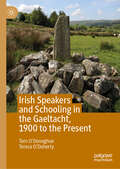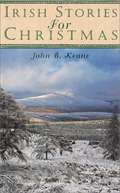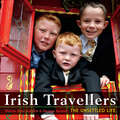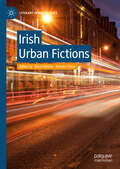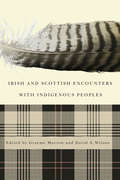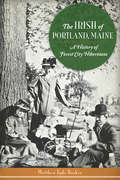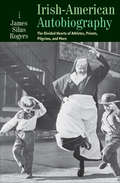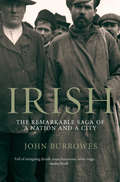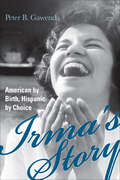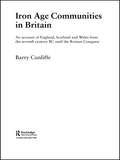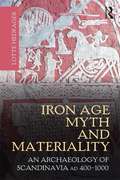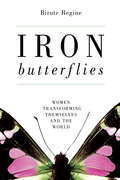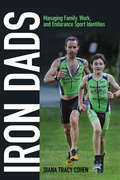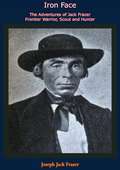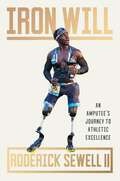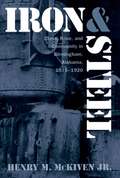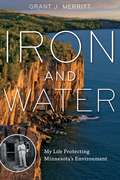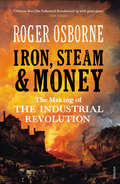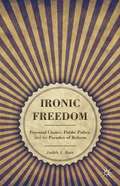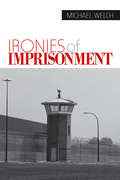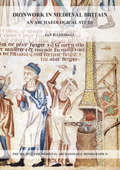- Table View
- List View
Irish Speakers and Schooling in the Gaeltacht, 1900 to the Present
by Tom O'Donoghue Teresa O'DohertyThis book offers the first full-length study of the education of children living within the Gaeltacht, the Irish-speaking communities in Ireland, from 1900 to the present day. While Irish was once the most common language spoken in Ireland, by 1900 the areas in which native speakers of Irish were located contracted to such an extent that they became clearly identifiable from the majority English-speaking parts. In the mid-1920s, the new Irish Free State outlined the broad parameters of the boundaries of these areas under the title of ‘the Gaeltacht’. This book is concerned with the schooling of children there. The Irish Free State, from its establishment in 1922, eulogized the people of the Gaeltacht, maintaining they were pious, heroic and holders of the characteristics of an invented ancient Irish race. Simultaneously, successive governments did very little to try to regenerate the Gaeltacht or to ensure Gaeltacht children would enjoy equality of education opportunity. Furthermore, children in the Gaeltacht had to follow the same primary school curriculum as was prescribed for the majority English speaking population. The central theme elaborated on throughout the book is that this schooling was one of a number of forces that served to maintain the people of the Gaeltacht in a marginalized position in Irish society.
Irish Stories for Christmas
by John D. KeaneThese aren't the usual kiddie bedtime, sermonizing or excessively sweet Christmas stories we usually find in Christmas fiction. These original stories by one of Ireland's master storytellers of the everyday people living in the Irish southwestern countryside, small towns and boglands make entertaining reading all year. Husbands, bachelors, uncles and grandfathers will be caught up in the adventures of Irishmen who haggle over pints in the pubs, barrels on the road, turf in the boglands and change in their pockets. There's no preaching here. Romance is in the air, a cat gets boiled in the best sobering up soup in memory, the good and the greedy get theirs and a banshee is unveiled. These quirky characters and their culture are disappearing as Ireland is modernized. Enjoy them in this engaging volume as they celebrate until dawn and awaken to some amazing holiday surprises. A short, friendly, glossary explains Irish words like bogdeal, cadhrawn, groodle and stoolin.
Irish Travellers: The Unsettled Life
by George Gmelch Sharon Bohn GmelchAnthropologists George and Sharon Gmelch have been studying the quasi-nomadic people known as Travellers since their fieldwork in the early 1970s, when they lived among Travellers and went on the road in their own horse-drawn wagon. In 2011 they returned to seek out families they had known decades before—shadowed by a film crew and taking with them hundreds of old photographs showing the Travellers' former way of life. Many of these images are included in this book, alongside more recent photos and compelling personal narratives that reveal how Traveller lives have changed now that they have left nomadism behind.
Irish Urban Fictions (Literary Urban Studies)
by Deirdre Flynn Maria BevilleThis collection is the first to examine how the city is written in modern Irish fiction. Focusing on the multi-faceted, layered, and ever-changing topography of the city in Irish writing, it brings together studies of Irish and Northern Irish fictions which contribute to a more complete picture of modern Irish literature and Irish urban cultural identities. It offers a critical introduction to the Irish city as it represented in fiction as a plural space to mirror the plurality of contemporary Irish identities north and south of the border. The chapters combine to provide a platform for new research in the field of Irish urban literary studies, including analyses of the fiction of authors including James Joyce, Roddy Doyle, Kate O’Brien, Hugo Hamilton, Kevin Barry, and Rosemary Jenkinson. An exciting and diverse range of fictions is introduced and examined with the aim of generating a cohesive perspective on Irish urban fictions and to stimulate further discussion in this emerging area.
Irish Writers and the Thirties: Art, Exile and War (Routledge Studies in Cultural History #99)
by Katrina GoldstoneThis original study focusing on four Irish writers – Leslie Daiken, Charles Donnelly, Ewart Milne and Michael Sayers – retrieves a hitherto neglected episode of Thirties literary history which highlights the local and global aspects of Popular Front cultural movements. From interwar London to the Spanish Civil War and the USSR, the book examines the lives and work of Irish writers through their writings, their witness texts and their political activism. The relationships of these writers to George Orwell, Samuel Beckett, T.S. Eliot, Nancy Cunard, William Carlos Williams and other figures of cultural significance within the interwar period sheds new light on the internationalist aspects of a Leftist cultural history. The book also explores how Irish literary women on the Left defied marginalization. The impetus of the book is not merely to perform an act of literary salvage but to find new ways of re-imagining what might be said to constitute Irish literature mid-twentieth century; and to illustrate how Irish writers played a role in a transforming political moment of the twentieth century. It will be of interest to scholars and students of cultural history and literature, Irish diaspora studies, Jewish studies, and the social and literary history of the Thirties.
Irish and Scottish Encounters with Indigenous Peoples: Canada, the United States, New Zealand, and Australia
by David A. Wilson Graeme MortonThe expansion of the British Empire during the eighteenth and nineteenth centuries created the greatest mass migration in human history, in which the Irish and Scots played a central, complex, and controversial role. The essays in this volume explore the diverse encounters Irish and Scottish migrants had with Indigenous peoples in North America and Australasia. The Irish and Scots were among the most active and enthusiastic participants in what one contributor describes as "the greatest single period of land theft, cultural pillage, and casual genocide in world history." At the same time, some settlers attempted to understand Indigenous society rather than destroy it, while others incorporated a romanticized view of Natives into a radical critique of European society, and others still empathized with Natives as fellow victims of imperialism. These essays investigate the extent to which the condition of being Irish and Scottish affected settlers' attitudes to Indigenous peoples, and examine the political, social, religious, cultural, and economic dimensions of their interactions. Presenting a variety of viewpoints, the editors reach the provocative conclusion that the Scottish and Irish origins of settlers were less important in determining attitudes and behaviour than were the specific circumstances in which those settlers found themselves at different times and places in North America, Australia and New Zealand. Contributors include Donald Harman Akenson (Queen's), John Eastlake (College Cork), Marjory Harper (Aberdeen), Andrew Hinson (Toronto), Michele Holmgren (Mount Royal), Kevin Hutchings (Northern British Columbia), Anne Lederman (Royal Conservatory of Music), Patricia A. McCormack (Alberta), Mark G. McGowan (Toronto), Ann McGrath (Australian National), Cian T. McMahon (Nevada), Graeme Morton (Guelph), Michael Newton (Xavier), Pádraig Ó Siadhail (Saint Mary's), Brad Patterson (Victoria University of Wellington), Beverly Soloway (Lakehead), and David A. Wilson (Toronto).
Irish of Portland, Maine, The: A History of Forest City Hibernians (American Heritage)
by Matthew Jude BarkerThe Irish have influenced the city of Portland since it was first established in the seventeenth century. Today's vibrant Catholic community owes its origins to Irish immigrants in Portland's earliest days, when beloved leaders like Father Ffrench provided solace to souls far from home. The church helped them adapt and adapted along with them, affecting the city in many ways. Portland's Irish faced discrimination, especially in the years before the Civil War, when anti-Irish sentiment surged and burnings and violence erupted, like the June 1855 Rum Riot. Despite this, many Portland Irish took up arms for the United States in the Civil War, and their participation in this conflict helped them become assimilated. Join local expert Matthew Jude Barker as he explores the triumphs and challenges of the Irish of Portland before the twentieth century..
Irish-American Autobiography: The Divided Hearts of Athletes, Priests, Pilgrims, and More
by James Silas RogersThis lively survey of the ever-changing Irish-American experience contains &“many perceptive, and sometimes surprising, observations&” (The Irish Times). Irish-American Autobiography explores the evolution of Irishness in America through memoirs that describe, define, and redefine what it means to be Irish. From athletes and entertainers to saloon keepers, community activists, and Catholic priests, Irish-Americans of all stripes share their thoughts and perceptions on their ever-evolving ethnic identity. Poet and Irish studies specialist James Silas Rogers begins his evocative analysis with celebrity memoirs by athletes like boxer John L. Sullivan and ballplayer Connie Mack―written when the Irish were eager to put their raffish origins behind them. Later, he traces the many tensions registered by lesser-known Irish-Americans who&’ve told their life stories. South Boston step dancers set themselves against the larger culture, framing their identity as outsiders looking in. Even the classic 1950s sitcom The Honeymooners speaks to the poignant sense of exclusion felt by its creator Jackie Gleason. Rogers also examines the changing role of Catholicism as a cultural touchstone for Irish Americans, and examines the painful diffidence of priest autobiographers. Irish-American Autobiography becomes, in the end, a story of a continued search for connection—documenting an &“ethnic fade&” that never quite happened.
Irish-American Landmarks: A Travelers Guide
by John A. BarnesFor Irish-Americans and non-Irish alike, this book is a rich quarry. The author, John Barnes, aims to instruct and to delight and does so very well. He offers all readers colorful snapshots of America's social and political history, which is so intertwined with the story of the Irish in America.
Irish/ness Is All Around Us: Language Revivalism and the Culture of Ethnic Identity in Northern Ireland
by Olaf ZenkerFocusing on Irish speakers in Catholic West Belfast, this ethnography on Irish language and identity explores the complexities of changing, and contradictory, senses of Irishness and shifting practices of 'Irish culture' in the domains of language, music, dance and sports. The author's theoretical approach to ethnicity and ethnic revivals presents an expanded explanatory framework for the social (re)production of ethnicity, theorizing the mutual interrelations between representations and cultural practices regarding their combined capacity to engender ethnic revivals. Relevant not only to readers with an interest in the intricacies of the Northern Irish situation, this book also appeals to a broader readership in anthropology, sociology, cultural studies, history and political science concerned with the mechanisms behind ethnonational conflict and the politics of culture and identity in general.
Irish: The Remarkable Saga of a Nation and a City
by John BurrowesIrish is the story of the mass migration from Ireland to Glasgow that took place in the wake of the Great Famine of the mid-nineteenth century. It is an epic account of the coming together of a nation and a city. This is the tale of those who escaped a nightmare existence in the poorest and most deprived country in Europe and changed the city of Glasgow forever. Irish brings to life the horrot of those grim days and reveals the unimaginable suffering endured as a result of the Potatoe Blight. It describes in vivid detail the hazards and hardships faced by those fleeing Ireland in search of a better life overseas, including a startling account of one of the most deplorable maritime crimes ever committed, the voyage of the SS Londonderry. The coming of the Irish to Glasgow had a bigger impact on the city than other event. Now, for the first time, the truth about this most significant and stirring episode is vividly unfolded. It tells of the contribution made by Irish labourers in Glasgow to the Industrial Revolution; reveals that the legendary football clubs of Celtic and Rangers may never have existed were it not for the migrant's arrival; and describes the "Partick War", and the occasion of the first-ever Orange Walk.
Irma's Story: American by Birth, Hispanic by Choice (Irma's Story Ser.)
by Peter B. Gawenda“The compelling true story of the impassioned love shared between a south Texas woman of Hispanic descent and a German military officer.” —Yvonne Freeman, PhD, professor, Department of Language, Literacy, and Intercultural Studies at the University of Texas at BrownsvilleAfter World War II, Peter, a handsome German pilot, met Irma, a beautiful Texan woman of Hispanic descent. It was love at first sight. Their meeting had been prophesized—for Irma by her grandmother and for Peter by a palm reader—and together the couple would create an extraordinary life. Irma’s Story: American by Birth, Hispanic by Choice chronicles Irma’s life and the experiences of the “Texan Gawendas” during their tenure in the German military in Europe and the United States. Though Irma, accepted as an American while in Europe, faced discrimination in her home country and contended with the challenges of being a military wife, Peter’s love and companionship remained constant.In his second book, Peter B. Gawenda, author of The Children’s War, offers readers an insider’s view of the joys that the marriage of two people—from two completely different worlds—can bring. Presenting the dynamics of racial issues against the backdrop of military life, the captivating story of Irma Lozano de Gawenda depicts a fearless, fiercely loyal woman willing to do anything for her family.Written with a passion that has spanned five decades, Irma’s Story celebrates the strength of a once-in-a-lifetime love.“He thrills [readers] again, turning to his narrative gifts and rich trove of memories to tell another story with universal appeal—the power of enduring love.” —Robert Becker, veteran journalist and former international wire news editor, Houston Chronicle
Iron Age Communities in Britain: An Account of England, Scotland and Wales from the Seventh Century BC until the Roman Conquest
by Barry CunliffeSince its first publication in 1971, Barry Cunliffe's monumental survey has established itself as a classic of British archaeology. This fully revised fourth edition maintains the qualities of the earlier editions, whilst taking into account the significant developments that have moulded the discipline in recent years. Barry Cunliffe here incorporates new theoretical approaches, technological advances and a range of new sites and finds, ensuring that Iron Age Communities in Britain remains the definitive guide to the subject.
Iron Age Myth and Materiality: An Archaeology of Scandinavia AD 400-1000
by Lotte HedeagerIron Age Myth and Materiality: an Archaeology of Scandinavia AD 400-1000 considers the relationship between myth and materiality in Scandinavia from the beginning of the post-Roman era and the European Migrations up until the coming of Christianity. It pursues an interdisciplinary interpretation of text and material culture and examines how the documentation of an oral past relates to its material embodiment. While the material evidence is from the Iron Age, most Old Norse texts were written down in the thirteenth century or even later. With a time lag of 300 to 900 years from the archaeological evidence, the textual material has until recently been ruled out as a usable source for any study of the pagan past. However, Hedeager argues that this is true regarding any study of a society’s short-term history, but it should not be the crucial requirement for defining the sources relevant for studying long-term structures of the longue durée, or their potential contributions to a theoretical understanding of cultural changes and transformation. In Iron Age Scandinavia we are dealing with persistent and slow-changing structures of worldviews and ideologies over a wavelength of nearly a millennium. Furthermore, iconography can often date the arrival of new mythical themes anchoring written narratives in a much older archaeological context. Old Norse myths are explored with particular attention to one of the central mythical narratives of the Old Norse canon, the mythic cycle of Odin, king of the Norse pantheon. In addition, contemporaneous historical sources from late Antiquity and the early European Middle Age - the narratives of Jordanes, Gregory of Tours, and Paul the Deacon in particular - will be explored. No other study provides such a broad ranging and authoritative study of the relationship of myth to the archaeology of Scandinavia.
Iron Balloons: Hit Fiction From Jamaica's Calabash Writer's Workshop
by Colin ChannerJamaica's literary lion Colin Channer presents new fiction from the freshest young Jamaican authors. Reggae's rebel spirit blazes in this hot selection of short fiction from Jamaica's Calabash Writer's Workshop. Set in the Caribbean and the U.S.A., the stories sweep across a range of moods and genres to create a narrative LP of fascinating voices. From the old lady who gives a "how to" speech on beating children, to the schizophrenic singer who thinks he's Bob Marley, to the hotel maid who gets a sexual offer that she can't refuse, the diverse mix of characters are linked by the fundamental principle that all cliched conventions must be shouted off the page. In the proudly odd tradition of Jamaican music, the selections seek to entertain while asking daring questions that provoke new ideas into being. Contributors include: Colin Channer, Elizabeth Nunez, Marlon James, Kwame Dawes, Kaylie Jones, Geoffrey Philp, Rudolph Wallace, Konrad Kirlew, Alwin Bully, A-dZiko Simba, and Sharon Leach.
Iron Butterflies
by Birute RegineA profound transition is taking place in our society, a revolution that is largely hidden, and led predominantly by women. A society once based on domination and power over others is beginning to crumble as an era of cooperation and community emerges, founded on the principle that power should only be exercised with and for others. This is the inspiring, central message of this compelling narrative that weaves together the stories of sixty successful women from all walks of life and throughout the world. The author spent several years in eight countries interviewing these dynamic female role models: businesswomen, CEOs, a Congresswoman, a governor, an ex-Prime Minister, a Pulitzer Prize finalist, a Nobel Peace Prize laureate, a winemaker, artists, doctors, nurses, and many others. The author calls these women "Iron Butterflies" because they meld a will of iron with the gentle, nurturing touch of a butterfly. With disarming candor, these women talk about their struggles, their fallibilities, and their strengths in the journey to the top of their professions. Forging their leadership from an amalgam of masculine and feminine skills, all of these Iron Butterflies have transformed themselves and in doing so they are contributing to a larger social transformation. A key to this personal and social transformation rests in their ability to address vulnerability in themselves and those around them, and transform it into a crucible of healing, growth, and innovation. Knowing how to deal with vulnerability, in ourselves and with others, evokes feminine skills and values and is a key to the societal change so many are seeking. Critiquing the command-and-control style of leadership, derived from the gladiator concept of male invulnerability, the author convincingly demonstrates how traditional feminine skills and values--such as inclusion, empathy, a holistic perspective, relational skills, and emotional strength--can be applied to empower more people than ever before. Like the sixty Iron Butterflies profiled, leaders in the 21st century will paradoxically embrace vulnerability and durability, creating better working and living relationships for us all.
Iron Dads: Managing Family, Work, and Endurance Sport Identities
by Diana Tracy CohenAmong the most difficult athletic events a person can attempt, the iron-distance triathlon--a 140.6 mile competition--requires an intense prerace training program. This preparation can be as much as twenty hours per week for a full year leading up to a race. In Iron Dads, Diana Tracy Cohen focuses on the pressures this extensive preparation can place on families, exploring the ways in which men with full-time jobs, one or more children, and other responsibilities fit this level of training into their lives. An accomplished triathlete as well as a trained social scientist, Cohen offers much insight into the effects of endurance-sport training on family, parenting, and the sense of self. She conducted in-depth interviews with forty-seven iron-distance competitors and three prominent men in the race industry, and analyzed triathlon blog postings made by Iron Dads. What sacrifices, Cohen asks, are required--both at home and at work--to cross the iron-distance finish line? What happens when work, family, and sport collide? Is it possible for fathers to meet their own parenting expectations while pursuing such a time-consuming regimen? With the tensions of family economics, how do you justify spending $5,000 on a racing bike? At what point does sport become work? Cohen discovered that, by fostering family involvement in this all-consuming effort, Iron Dads are able to maintain a sense of themselves not only as strong, masculine competitors, but also as engaged fathers. Engagingly written and well researched, Iron Dads provides a penetrating, firsthand look at extreme endurance sports, including practical advice for aspiring racers and suggestions for making triathlons more family-friendly.
Iron Face: The Adventures of Jack Frazer Frontier Warrior, Scout and Hunter
by Joseph Jack Frazer Henry Hastings SibleyWritten in the 1850’s by Henry Hastings Sibley, recorded first hand from Iron Face, a half-breed Sioux warrior and scout. Frazer, also was a half-breed born and raised in a Sioux village. Includes information on the Black Hawk War and the Minnesota Massacre. Vestal says, “We are lucky, I think, to have this story in any form. Its chief service is a tool to help us understand a kind of life now gone forever.” Stanley Vestal states that this volume presents a close-up picture of the Indians. Jack Frazer was a half-breed whose Sioux name was Iron Face. “There is no lace or perfume in theis book, no gilding of the aboriginal lily . . .”With Introduction And Notes By Theodore C. Blegen And Sara A. Davidson.
Iron Will: An Amputee's Journey to Athletic Excellence
by Roderick SewellThe story of the first bilateral above-the-knee amputee to become and IRONMAN champion. Roderick Sewell II was born without the tibia in both of his legs. Before he turned two years old, his mother, Marian, made the tough choice to have his legs amputated so that he could continue wrestling with his cousins and climbing his grandmother&’s good furniture. But when Marian&’s modest income couldn&’t cover the prosthetics Roderick needed to attend school, she made another impossible decision: to leave her job so that California Children&’s Services would pay for Roderick&’s prosthetic legs. Roderick and his mother were left homeless, keeping their long stays in shelters a secret while he learned to swim at the YMCA. All the while, Marian instilled in Roderick the lessons of gratitude, love, and patience to build his confidence in his disability, his identity as a Black boy, and his true passion, sports. Roderick was still homeless when he met coaches from the Challenged Athletes Foundation. They gave him his running legs, and his life quickly changed for the better. He learned how to challenge his body to become a fierce competitor and athlete—with his mom cheering from the sidelines all the while.Iron Will is the story of an athlete with an indomitable spirit and proof that a winner&’s mindset is about more than physical and mental endurance. It&’s about the unique places you can find love, and the rewards of conquering your fears.
Iron and Steel
by Henry M. MckivenIn this study of Birmingham's iron and steel workers, Henry McKiven unravels the complex connections between race relations and class struggle that shaped the city's social and economic order. He also traces the links between the process of class formation and the practice of community building and neighborhood politics. According to McKiven, the white men who moved to Birmingham soon after its founding to take jobs as skilled iron workers shared a free labor ideology that emphasized opportunity and equality between white employees and management at the expense of less skilled black laborers. But doubtful of their employers' commitment to white supremacy, they formed unions to defend their position within the racial order of the workplace. This order changed, however, when advances in manufacturing technology created more semiskilled jobs and broadened opportunities for black workers. McKiven shows how these race and class divisions also shaped working-class life away from the plant, as workers built neighborhoods and organized community and political associations that reinforced bonds of skill, race, and ethnicity.
Iron and Water: My Life Protecting Minnesota's Environment
by Grant J. MerrittA memoir of family, mining pioneers and unscrupulous magnates, and the fight for Minnesota&’s natural resources In 1855 the Merritt family arrived in Minnesota, where a descendant, Alfred, would one day become one of the &“Seven Iron Men&”—builders of the first mines to tap the state&’s great mineral wealth in the Mesabi Range. Another Merritt, more than half a century later, would lead the efforts to protect Lake Superior from damage caused by mining. Iron and Water is Grant J. Merritt&’s memoir of his life&’s work on behalf of Minnesota&’s people and environment and also the story of a significant family in state history.Merritt&’s family played a key role in the struggle over natural resources in Minnesota—for the enrichment of mining pioneers, the prosperity of the state and its people, and the prospect of a secure and healthy future. This complex tale begins with the adventure of discovering iron ore and building the mines, railroads, and docks to move it, then devolves into the intrigues of business partnerships gone bad and attempts by John D. Rockefeller to defraud the Merritts. What follows is an engrossing account of Grant Merritt&’s years in the halls of state politics and the trenches of environmental activism in defense of Minnesota&’s North Shore and Lake Superior&’s waters. The author&’s tenure as head of the Minnesota Pollution Control Agency under Governor Wendell Anderson and his service on the first board of the Minnesota Environmental Quality Council take us behind the scenes of landmark legal cases and crucial moments in Minnesota history—particularly the notable Reserve Mining case, in which the company was found liable for serious environmental and health threats on the shores of Lake Superior and ordered to be shut down. In these pages we encounter the people who were critical to this history, from robber baron Rockefeller to judges, activists, and politicians, including Walter Mondale and Jim Oberstar. In chronicling both the discovery of vast iron deposits on the Mesabi Range and the fight to save Lake Superior and Minnesota&’s natural riches, Iron and Water reveals how, whether alone or together, individuals wield the power to change the world.
Iron, Steam & Money: The Making of the Industrial Revolution
by Roger OsborneIn late eighteenth-century Britain a handful of men brought about the greatest transformation in human history. Inventors, industrialists and entrepreneurs ushered in the age of powered machinery and the factory, and thereby changed the whole of human society, bringing into being new methods of social and economic organisation, new social classes, and new political forces. The Industrial Revolution also dramatically altered humanity's relation to the natural world and embedded the belief that change, not stasis, is the necessary backdrop for human existence.Iron, Steam and Money tells the thrilling story of those few decades, the moments of inspiration, the rivalries, skulduggery and death threats, and the tireless perseverance of the visionaries who made it all happen. Richard Arkwright, James Watt, Richard Trevithick and Josiah Wedgwood are among the giants whose achievements and tragedies fill these pages. In this authoritative study Roger Osborne also shows how and why the revolution happened, revealing pre-industrial Britain as a surprisingly affluent society, with wealth spread widely through the population, and with craft industries in every town, village and front parlour. The combination of disposable income, widespread demand for industrial goods, and a generation of time-served artisans created the unique conditions that propelled humanity into the modern world.The industrial revolution was arguably the most important episode in modern human history; Iron, Steam and Money reminds us of its central role, while showing the extraordinary excitement of those tumultuous decades.
Ironic Freedom: Personal Choice, Public Policy, and the Paradox of Reform
by Judith BaerIronic Freedom asserts that freedom from governmental interference may make people vulnerable to other sources of coercion; these affects vary by gender, race, and class. Increasing negative freedoms may reinforce existing asymmetrical power relationships within society.
Ironies of Imprisonment: Social Control And The Ironies Of Imprisonment
by Michael WelchFrom the Foreword "Michael Welch′s book is an invitation to think. It is an invitation to grow intellectually and critically, as a consumer of crime policy and an observer of the American scene. Written by a scholar who has dedicated his work to uncovering the hidden ironies of formal crime policy, this is a collection of essays of depth and significance." -Todd R. Clear, Distinguished Professor, John Jay College of Criminal Justice Praise for Ironies of Imprisonment:"The American correctional system is too often misshaped by a toxic mixture of ideology, anti-intellectualism, wishful thinking, and structural interests. Michael Welch uses his substantial critical skills to illuminate how these various factors intersect to create policies and practices that produce, in the end, more injustice and less public safety. His sobering analysis deconstructs the rhetoric used to justify mass imprisonment and its unanticipated, disquieting consequences."-Frank Cullen, University of Cincinnati "Michael Welch has written a book which anyone who is looking for an alternative to conventional and conservative approaches to prisons and punishment should read. Welch provides the groundwork for the development of a penology which engages critically with the growing tensions and ironies of imprisonment." -Roger Matthews, Middlesex University Ironies of Imprisonment examines in-depth an array of problems confronting correctional programs and policies from the author′s singular and consistent critical viewpoint. The book challenges the prevailing logic of mass incarceration and traces the ironies of imprisonment to their root causes, manifesting in social, political, economic, and racial inequality. Key Features A compelling Foreword written by Todd E. Clear, an internationally recognized leader in the field of criminal justice. Chapters open with illuminating real-life vignettes and end with provocative review questions. The author′s knowledgeable and dynamic voice provides a consistent perspective on key issues such as the war on drugs, the war on terror, prison violence, capital punishment, health care, and the prison industry. Up-to-date presentation of pertinent subject matter, including chief developments in research and theory. Discussion of the problems facing corrections in a post-September 11th world. Unique and accessible, this book promises to stimulate spirited discussion and debate over the use of prisons. Ironies of Imprisonment is recommended reading for students in corrections classes at the undergraduate and graduate levels in sociology, criminology, and criminal justice departments. In addition, it can be used in conjunction with a core text in courses on policy, theories of punishment, and social problems. The book will also be of interest to a general audience interested in reading about incarceration. Michael Welch is the author of numerous articles and several books on the subject of punishment and social control, including Punishment in America (1999), Flag Burning: Moral Panic and the Criminalization of Protest (2000), and Detained: Immigration Laws and the Expanding I.N.S. Jail Complex (2002). He has correctional experience at the federal, state, and local levels. Welch received a Ph.D. in sociology from the University of North Texas, Denton and is Associate Professor of Criminal Justice at Rutgers University.
Ironwork in Medieval Britain: An Archaeological Study (The Society for Medieval Archaeology Monographs)
by Ian H. Goodall"This monograph is the definitive survey of iron tools and other fittings in use during the period c1066 to 1540AD. Exceptional in a north-western European context for its range and coverage of artefacts from both rural and urban excavations, much of the material described here was recovered during 'rescue' projects in the 1960s and 1970s funded by the State through the Ministry of Public Works and Buildings and their successors. The text contains almost everything necessary to identify, date and understand medieval iron objects. In scope and detail there is still no published parallel and, as such, it will be essential for almost any archaeologist working in later medieval archaeology, particularly in the fields of excavation, finds study, museums and research."
